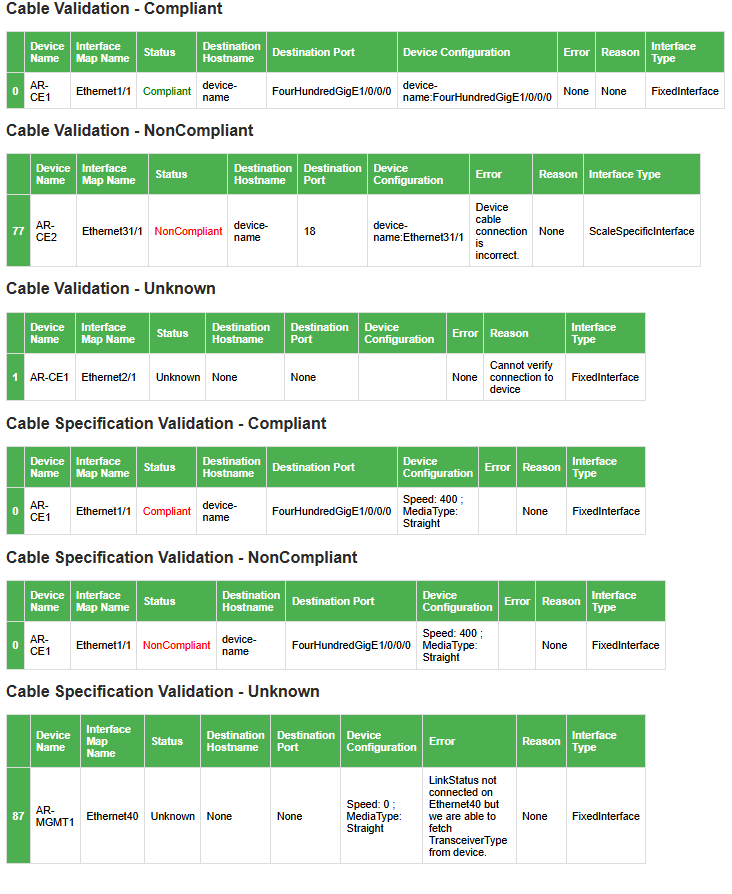如何將網路網狀架構纜線驗證報告轉換為 HTML
本文說明如何將 Nexus 網路網狀架構纜線驗證報告從 JSON 輸出轉換成 HTML。
必要條件
- 需要 Python 3.11 或更新版本
- 需要 Python 3.11 模組:
json pandas as pd datetime
適用於纜線驗證 JSON 至 HTML 轉換的 Python 腳本
import json
import pandas as pd
from datetime import datetime
def color_status(val):
"""
Takes a scalar and returns a string with
the css property `'color: green'` for compliant,
`'color: red'` for noncompliant and black for others
"""
if val == 'Compliant':
color = 'green'
elif val == 'NonCompliant':
color = 'red'
else:
color = 'black'
return 'color: %s' % color
now = datetime.now() # current date and time
date_time = now.strftime("%m-%d-%Y-%H-%M")
print("date and time:",date_time)
# Get the file name as input from the user
file_name = input("Please provide post validation json file: ")
# Load the JSON data from the file
with open(file_name, 'r') as f:
data = json.load(f)
# Prepare two lists to store the data
cable_validation_data = []
cable_specification_validation_data = []
# Loop through each rack in the racks list
for rack in data['racks']:
# Loop through each device in the networkConfiguration list
for device in rack['rackInfo']['networkConfiguration']['networkDevices']:
# Loop through each interface map for the device
for interface_map in device['fixedInterfaceMaps']:
# Loop through each validation result for the interface map
for validation_result in interface_map['validationResult']:
# Append the data to the list based on validation type
temp_item = [device['name'], interface_map['name'], validation_result['status'], interface_map['destinationHostname'], interface_map['destinationPort'],validation_result['validationDetails']['deviceConfiguration'], validation_result['validationDetails']['error'] , validation_result['validationDetails']['reason'],'FixedInterface']
if validation_result['validationType'] == 'CableValidation':
cable_validation_data.append(temp_item)
elif validation_result['validationType'] == 'CableSpecificationValidation':
cable_specification_validation_data.append(temp_item)
# Check if scaleSpecificInterfaceMaps is not None
if device['scaleSpecificInterfaceMaps'] is not None:
# Loop through each scaleSpecificInterface_Map for the interface map
for scale_map in device['scaleSpecificInterfaceMaps']:
# Loop through each interface map for the device.
for interfacemaps in scale_map['InterfaceMaps']:
# Loop through each validation result for the scaleSpecificInterface_Map
for validation_result in interfacemaps['validationResult']:
# Append the data to the list
temp_item = [device['name'], interfacemaps['name'], validation_result['status'], interfacemaps['destinationHostname'], interfacemaps['destinationPort'], validation_result['validationDetails']['deviceConfiguration'], validation_result['validationDetails']['error'] , validation_result['validationDetails']['reason'], 'ScaleSpecificInterface']
if validation_result['validationType'] == 'CableValidation':
cable_validation_data.append(temp_item)
elif validation_result['validationType'] == 'CableSpecificationValidation':
cable_specification_validation_data.append(temp_item)
# Convert the lists to DataFrames
cable_validation_df = pd.DataFrame(cable_validation_data, columns=['Device Name', 'Interface Map Name', 'Status', 'Destination Hostname', 'Destination Port', 'Device Configuration', 'Error', 'Reason', 'Interface Type'])
cable_specification_validation_df = pd.DataFrame(cable_specification_validation_data, columns=['Device Name', 'Interface Map Name', 'Status', 'Destination Hostname', 'Destination Port', 'Device Configuration', 'Error', 'Reason', 'Interface Type'])
# Group the DataFrames by 'Status' and append each group's HTML representation to a string
#html_string = '<html><head><style>table {border-collapse: collapse;} th, td {border: 1px solid black; padding: 5px;}</style></head><body>'
html_string = """
<html>
<head>
<style>
body {
font-family: Arial, sans-serif;
max-width: 960px; /* Set the maximum width of the page */
margin: 0 auto; /* Center the page */
}
h2 {color: #2A2A2A;}
table {border-collapse: collapse; width: 100%;}
th, td {border: 1px solid #ddd; padding: 8px;}
tr:nth-child(even) {background-color: #f2f2f2;}
th {padding-top: 12px; padding-bottom: 12px; text-align: left; background-color: #4CAF50; color: white;}
</style>
</head>
<body>
"""
for status, group_df in cable_validation_df.groupby('Status'):
styled_group_df = group_df.style.applymap(color_status, subset=['Status']).set_table_attributes('class="dataframe"')
html_string += f'<h2>Cable Validation - {status}</h2>'
html_string += styled_group_df.to_html()
for status, group_df in cable_specification_validation_df.groupby('Status'):
styled_group_df = group_df.style.applymap(color_status, subset=['Status']).set_table_attributes('class="dataframe"')
html_string += f'<h2>Cable Specification Validation - {status}</h2>'
html_string += styled_group_df.to_html()
html_string += '</body></html>'
# Write the string to an HTML file
with open('CableValidationAndSpecification-{filename}.html'.format(filename = date_time), 'w') as f:
f.write(html_string)
使用方式
若要執行轉換工具,請執行下列命令:
python cable-html.py
..
Please provide post validation json file: <CABLE_VALIDATION_FILENAME>.json
報表輸出具有檔案名 CableValidationAndSpecification-<DATE>.html。
纜線驗證報告 HTML 結果
報表會分成下列各節:
- 纜線驗證 - 符合規範
- 纜線驗證 - 不符合規範
- 纜線驗證 - 未知
- 纜線規格驗證 - 符合規範
- 纜線規格驗證 - 不符合規範
- 纜線規格驗證 - 未知
